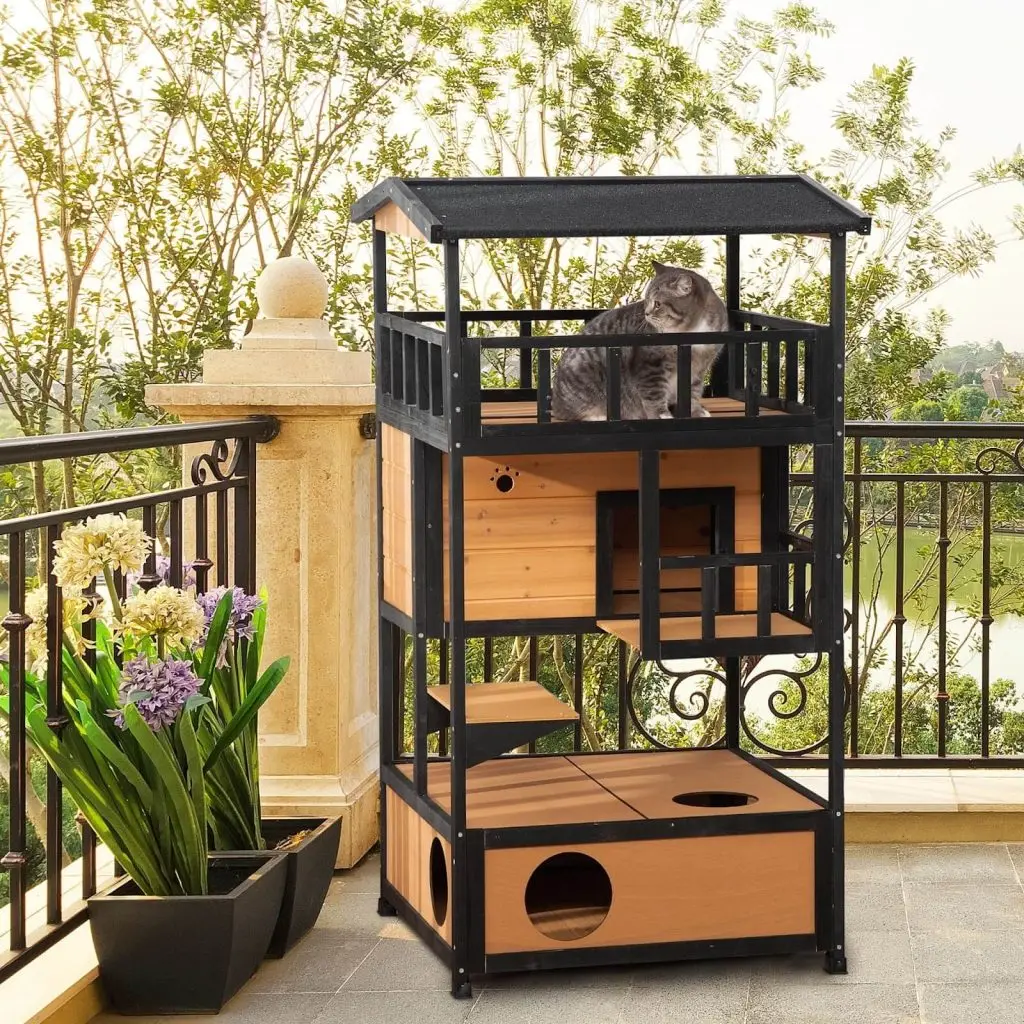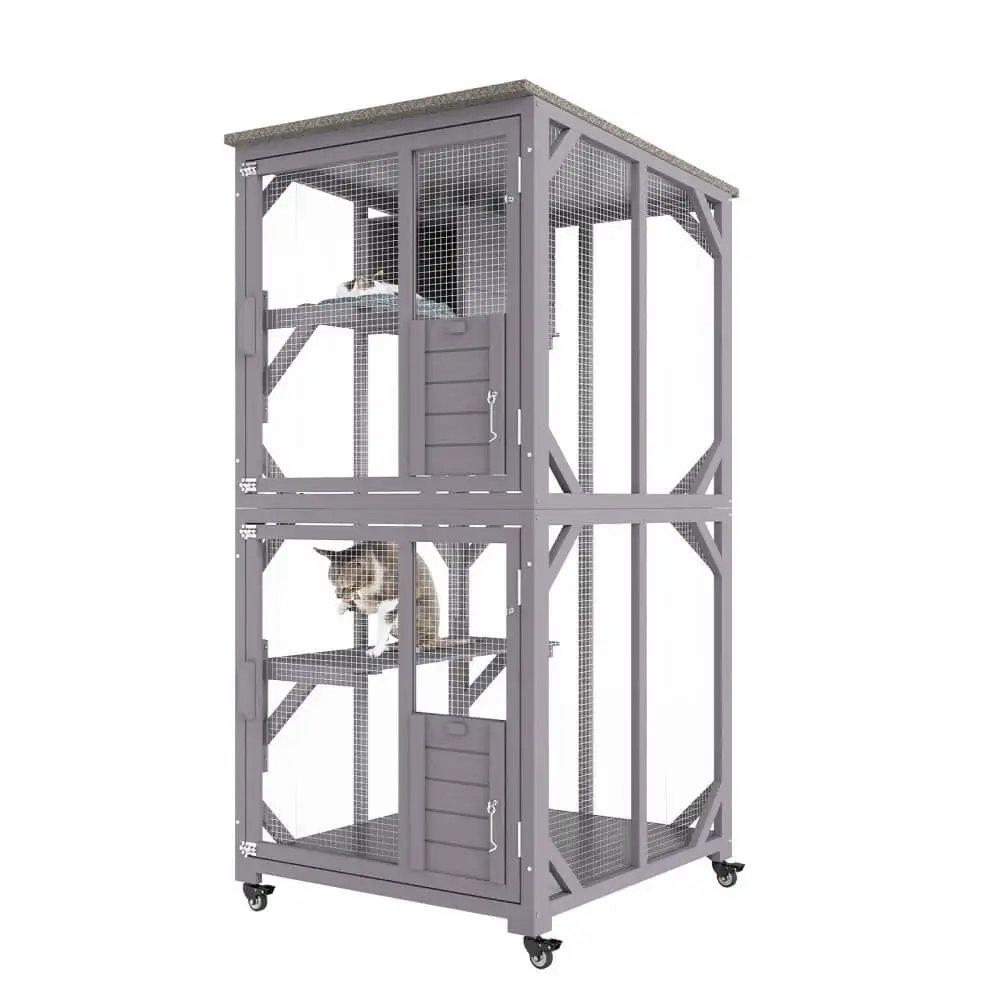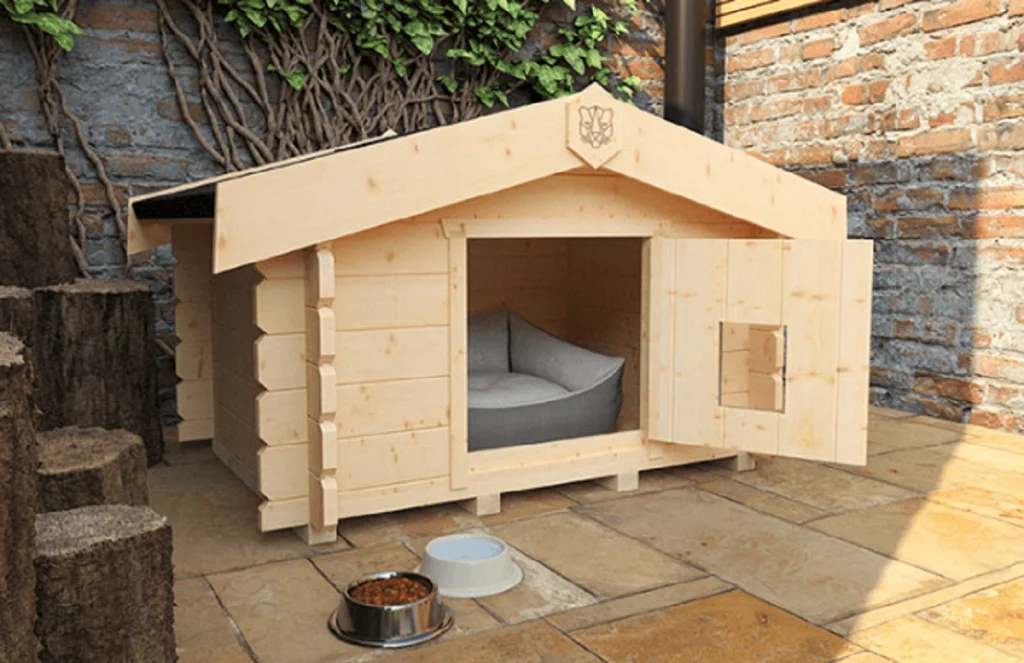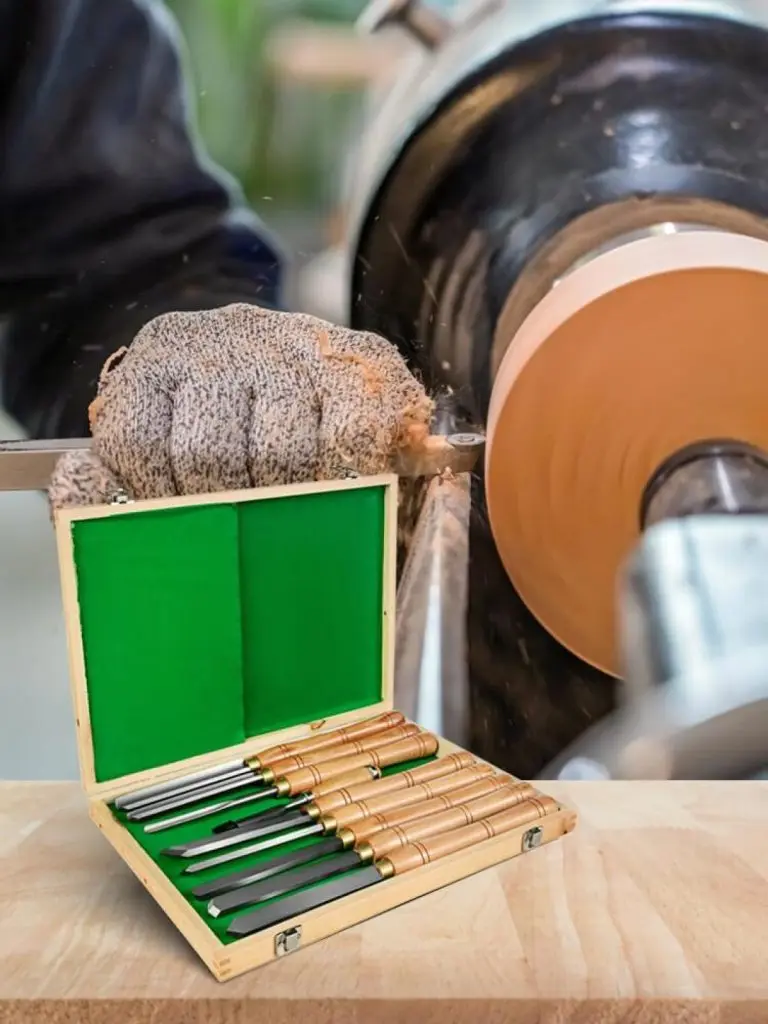Across the country and the world, you can see cats living outdoors, even in your own neighborhood! These neighborhood cats flourish in their outdoor surroundings and are experts at living outdoors.
Occasionally, such as during the colder months of winter, cats will be grateful for your help. You can help them by building a cozy outdoor shelter.
Despite cats’ resilience, having an outdoor cat shelter can help make living outside more comfortable as it gives them a place to sleep, relax, warm up, and keep safe. But, how do you build a DIY outdoor cat house?
This guide will help you make a homemade outdoor cat house in 6 simple steps.
Table of contents
Why Build an Outdoor Cat House? Benefits of Creating a Feline Haven

Before you ponder upon the question of how to build a cat house, you need to know the benefits it offers to cats. This will allow you to customize the house based on their needs.
Protection from the Elements
Constructing an outdoor cat house is a great way of providing your cats with their basic needs in terms of shelter from the weather. It gives them a safe place to hide from the cold or heavy rain and to stay away from potential predators.
Year-Round Comfort
Homemade cat houses for the outside are specially made to withstand the elements of weather. They include insulated roofs, walls, and ground to make sure the heat doesn’t escape from the house during winter. The house also includes ventilation to let air flow and keep the insides cool during summer.
Affordable and Fun DIY Option
Hand-made cat houses are quite a fulfilling and low-cost project.
| Feature | DIY Cat House | Store-Bought Cat House |
| Cost-Effectiveness | Generally more affordable; can use recycled or budget-friendly materials | Higher upfront cost; prices vary by brand and features |
| Personalization | Fully customizable | Limited customization |
| Quality Control | Quality depends on materials and skill | Professionally made, generally high-quality, and durable |
| Time and Effort | Requires time, tools, and DIY skills; may need occasional adjustments | Ready-to-use with minimal assembly or maintenance required |
| Unique Look | One-of-a-kind design; can be personalized with colors, patterns, or unique structures | Pre-designed styles; lack the individual touch of DIY projects but are efficient. |
Step-by-Step Guide: How to Make a DIY Outdoor Cat House
Coming to the main part for which you all are here, how to make an outdoor cat house. So, here’s a step-by-step guide for building a cat house DIY outdoor structure that’s cozy, weatherproof, and safe for your feline friends.
Step 1 – Select the Perfect Design for Your Needs
Before you start building your DIY cat house outdoor structure, consider the climate and your skill level. Here are some options you can consider:
- Wooden Structures: Wooden cat houses are durable, provide excellent insulation, and blend in with the outdoors. Constructing a wooden house requires more instruments and skills like cutting, measuring, and drilling. For cooler regions, adding insulation in between the double-layering walls can help hold onto heat. Wood is a wonderful choice if you are comfortable constructing it yourself, and you want it to be strong and unique in size.
- Plastic Totes: A beginner and cheaper option is to use a plastic storage box as a skeleton. These boxes are light, easy to handle, and you need way less equipment. However, they should be further insulated with foam or straw, so that they remain warm in the cold season.
- Insulated Models: If you live in a colder winter area, insulation should be your main focus. Insulated models are usually constructed with two layers of foam or straw in between. This can keep heat in. Despite it being costly and time-consuming, these types offer a comfortable stay in extreme weather conditions.
Step 2 – Gather Essential Materials and Tools
Now that you have a design in mind, gather the materials and tools:
Suggested Materials:
- Plywood
- Plastic totes
- Weatherproof paint
- Straw or insulation foam
- Outdoor-safe adhesives
- Screws
Basic Tools Needed:
- Power drill
- Hand saw
- Measuring tape
- Screwdriver
- Sandpaper
Step 3 – Constructing the Base and Frame
The first and foremost thing to do for your cat house is to build a solid foundation so that the structure is strong enough to stand.
- Create a Solid Bottom: Choose a firm base to raise the house off the floor to prevent heat loss and moisture transfer. If you’re building with wood, cut a baseboard that covers a square or rectangular area that is the size of your design. You can either attach shorter legs or simply use bricks to elevate the house by some inches. This will improve insulation and the interior will remain dry, which prevents the growth of molds and mildew.
- Create The House Frame: Make sure that you measure and cut the walls according to your design. If plywood was used, ensure that all pieces are cut precisely. Use a power drill to join the walls, making sure that each joint is securely screwed to the walls for stability. Also, use cross-beams at the corners or in the middle of the walls, depending on the size, to add extra stability. A frame that is properly reinforced is one of the things that can withstand changing weather conditions and keep it from falling apart over time.
Step 4 – Insulate and Waterproof for All-Weather Comfort
Weatherproofing and insulation are important to achieve the desired degree of comfort for a cat house.
Put foams or straws in between the walls if your house is double-wall designed. Panels of foam provide the heat-trapping effect during winter. If you have a plastic tote, then fill the interior with several layers of thick and long straw.
This method not only acts as a natural insulation but also serves as a warm surface for cats to snuggle into. Stay away from blankets and fabrics as they are easily absorbable to moisture and mildew can develop them.
On the outside, brush or use a roller to apply a layer of rain, sun, and windproof paint. Securely cover all joints, and especially make sure that the roof is leakproof. Apply some caulking along the joints and the corners to make it weather-resistant. For example, if you are using a plastic tote, look for any cracks, holes, or weak spots, and seal them with waterproof tape or adhesive.
Step 5 – Create Entrances and Exits for Safety
The entrances should be delicately cut and polished, making sure the edges are sanded to avoid injuries. You can also add a flap or a piece of overhang above the entrance to prevent wind and rain from entering the house.
Look into adding a second exit for a safe escape in case your cat happens to encounter potential threats.
Step 6 – Final Touches: Bedding, Comfort, and Additional Features
Add soft bedding inside the house to make it cozy. Use heat pads for pets or a hot water bottle as a supplement during the winter season for added warmth if it gets cold outside.
If you are going to use the above suggestion, using a non-toxic paint spray for the style or placing scratching rods for basking on the roof is recommended. Add some personal touch to make the house so nice that your pet will fall in love with it!
VEVOR Outdoor Cat House: A Quality Alternative to DIY

Talking about a protected do-it-yourself cat house but don’t have the time to do it? VEVOR’s outdoor cat houses serve as a reliable substitute for DIY projects. They are not just designed by professionals but carry with them a couple of winning attributes that are worthy of your attention as well.
Recommended For Your Project
VEVOR Advantages:
- Great thermal consistency in winter and summer.
- Strongly made framing resists cold, warm, rain, and storms.
- Assembly becomes easy with the inclusion of clear instructions and pre-drilled parts.
- Gives multiple levels or platforms that they can climb and explore.
- Hideout compartments for sleeping and relaxation.
- Expandable front doors are the way to go for both cleaning and getting in and out.
The VEVOR cat house offers a cat owner a trouble-free way to have a nicely designed outdoor place for their cat without having to go through the hassle of building a homemade cat house outdoor structure.
FAQs on Building and Maintaining Your DIY Outdoor Cat House
Best insulation materials?
If you want to make an outdoor cat house, foam boards, and straw are two of the best insulation options. Foam boards are lightweight, effective at retaining heat, and can be cut to fit the walls of the house. Straw is another excellent choice because it provides natural insulation, resists moisture, and creates a cozy environment for cats to burrow in. Avoid using hay, as it can become moldy in damp environments.
Seasonal maintenance tips
To keep the cat house in good condition year-round, follow these tips:
- Fall/Winter: Check for any gaps or damage to keep out drafts and add extra insulation, like a layer of straw, to help with warmth. Clean and refresh bedding regularly to prevent odors and moisture build-up.
- Spring/Summer: Deep clean the house by washing it down with mild soap and water. In warmer months, add ventilation to keep it cool and dry out any moisture that’s built up.
Cost-effective waterproofing methods
If you want to make an outdoor cat house under a budget, apply weatherproof paint to the exterior of wooden structures. It provides good water resistance and durability. Outdoor-safe caulking is useful for sealing edges, joints, and any small cracks. If using a plastic tote, waterproof tape can patch up any weak spots or seams to keep rain out.
Conclusion: Provide a Cozy and Secure Outdoor Shelter for Your Cat Year-Round
Now that we have covered the topic of how to make an outside cat house, let’s get down to the work. Creating a cozy and secure outdoor shelter for your cat is a wonderful way to keep them safe and comfortable all year. Building a DIY cat house lets you add personal touches and can be budget-friendly, especially if you enjoy hands-on projects. With the right materials, insulation, and waterproofing, you can build a shelter that provides great protection against the elements.
If you want a convenient, ready-made option, VEVOR’s outdoor cat houses offer sturdy construction, insulation, and space for multiple cats—all with minimal setup.





